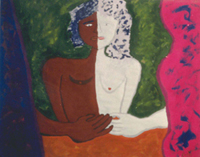Copyright © Kate Donohue and Tina Stromsted.
“In the deepest sense, we all dream not of ourselves, but out of what lies between us and the other.”
– C.G. Jung
Our first relationship to the self and others is through the body. As we are embraced by the mother’s body, we become familiar with intimacy and ourselves. As this relationship develops, images, sound and word help us define and understand these interconnections on deeper levels. This challenging time on our planet also asks us to explore our inner “other,” owning shadow material, engaging body wisdom, and developing compassion, Through Authentic Movement, visual art, drama, sandplay and poetry, we will explore what evokes and nourishes relationship, illuminating the power of creativity and community in this transformative process.
Instructors:
Tina Stromsted, Ph.D., ADTR, past co-founder of and faculty at the Authentic Movement Institute. She teaches at universities and healing centers internationally. With thirty years of clinical practice, her publications and consultation explore the integration of body, psyche and soul in clinical work. She is a Candidate at the C. G. Jung Institute in San Francisco, and in private practice. www.AuthenticMovement-BodySoul.com
Kate T. Donohue, Ph.D., REAT
Through consultation, writing and private practice, Kate’s life work for the past thirty years has been to create a marriage between Jungian theory and expressive arts therapy. Her personal experiences with the sacred feminine in Southwest women’s art and West African dance have greatly informed her current work.
Course Description
Though the individuation journey asks each of us to open to the unknown and discover our wholeness, it does not occur in isolation. Kinship Libido, our desire for connection and search for wholeness through relationship, is most dramatically experienced in a collaborative weaving of the arts.
This workshop will invite participants to engage in an expressive arts approach, exploring the intersubjective relationship between the individual and the collective that Jung understood as the participation mystique. Through this experience we will discover what evokes and nourishes relationship, illuminating the power of creativity and the participation mystique in this transformative process. Beginning with storytelling evoked by sacred found objects, participants will investigate how images hold intrapsychic, interpersonal, and transpersonal meaning for the individual and for the group.
Concepts that will be examined include the participation mystique/intersubjective field, the power of images to evoke and explore the transcendent function, and a theoretical approach to weaving the arts into healing and transformative tapestries.
Participants, individually and through group interaction, will then apply these concepts in an experiential process integrating Authentic Movement, Visual Arts, and Poetry. A form of Jung’s active imagination, Authentic Movement invites a descent into the body and psyche within a safe environment; an opportunity to bring awareness, expression, and form to the soul’s deeper callings as they are expressed through natural movement.
Fresh from their own inner landscape, participants will discover how each person’s mysteries may have been revealed in the encounter with others and deepened through this interaction. Together, we will discover ways each individual informs the collective and the collective informs the individual in the vibrant web of life.
Learning Objectives:
Participants will understand and learn how to incorporate the following elements into their lives and work:
The concept of the “participation mystique” and how it informs the intersubjective experience of an individual and the community.
How the arts are integral in the development of the intersubjective experience of the individual and the community.
How to access images in a variety of creative modalities, exploring their intrapsychic, interpersonal, and transpersonal aspects.
An increased sense of comfort and appreciation for one’s own bodily experience – its wisdom, intuitive, and feeling responses – toward enhancing self care and empathy and effectiveness in working with others.
Required Readings
“The Concept of Participation” by Verena Kast, in The Interactive Field, by Murray Stein.
” Dance therapy and the transcendent function” by Joan Chodorow. (1977). In P. Pallaro (Ed.) Authentic Movement: Essays by Mary Starks Whitehouse, Janet Adler, and Joan Chodorow (pp. 236-252). Philadelphia: Jessica Kingsley Publishers, 1999.
“The Tao of the Body” by Mary Whitehouse. (1958). In P. Pallaro (Ed.) Authentic Movement: Essays by Mary Starks Whitehouse, Janet Adler, and Joan Chodorow (pp. 41-50). Philadelphia: Jessica Kingsley Publishers, 1999.
Creative and Expressive Arts Therapy Introductory Bibliography
Resource Bibliography
Suggested Course Readings
Chodorow, Joan, (1977). Dance therapy and the transcendent function. In P. Pallaro (Ed.) Authentic Movement: Essays by Mary Starks Whitehouse, Janet Adler, and Joan Chodorow (pp. 236-252). Philadelphia: Jessica Kingsley Publishers, 1999.
Kast, V. (1995). A concept of participation, in M. Stein, M (ed.), The Interactive Field in Analysis. Wilmette, Illinois: Chiron Press.
Lewis, P. (1993). Creative Transformation: The Healing Power of the
Arts. Wilmette, Illinois: Chiron Press.
Whitehouse, M. (1958). The Tao of the Body. In P. Pallaro (Ed.) Authentic Movement: Essays by Mary Starks Whitehouse, Janet Adler, and Joan Chodorow (pp. 41-50). Philadelphia: Jessica Kingsley Publishers, 1999.
Books on Reserve in the San Francisco C.G. Jung Library:
Chodorow, J. (1991). Dance therapy and depth psychology: The moving imagination. New York: Routledge.
_________. (Ed.). (1997). Jung on active imagination. Princeton, N.J.: Princeton University Press.
Johnson, Don .H. & Ian J. Grand (Eds.),The Body in Psychotherapy. North Atlantic Books and The California Institute of Integral Studies.
Jung, C.G. (1946/1992). The psychology of the transference. (R.F.C. Hull, Trans.).
Knill, P., Barba, H., Fuchs-Knill, M. (1994). Minstrels of Soul: Intermodal Expressive Therapy, Toronto, Ontario: Palmerston Press.
Levine, S. & Levine, E. (eds.). The Foundations of Expressive Arts Therapy, London & Philadephia: Jessica Kingsley Publishers.
Lewis, P. (1993). Creative Transformation. Wilmette, Illinois: Chiron Publications.
Pallaro , Patrizia. (Ed.), (1999). Authentic movement: Essays by Mary Starks Whitehouse, Janet Adler, and Joan Chodorow. London: Jessica Kingsley Publishers.
Schwartz-Salant, Nathan & Murray Stein (Eds.),The body in analysis . Wilmette, I Illinois: Chiron Publications.
M. Stein, M (ed.), The Interactive Field in Analysis. Wilmette, Illinois: Chiron Press.
Schwartz-Salant, N. & Stein, M. (Eds.) Transference Countertransference, Wilmette, Illinois: Chiron Publications.
Back to Embracing the Inner ‘Other’: Archetypes, Arts and the Body








